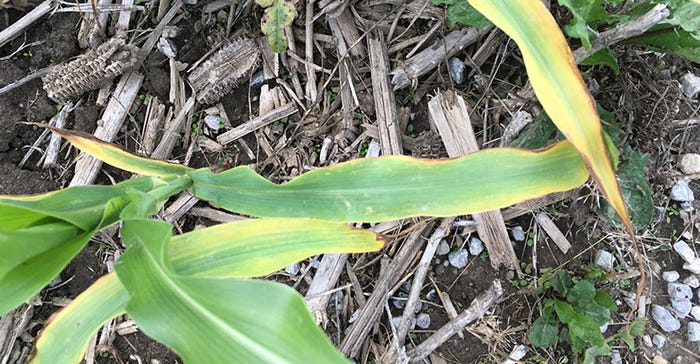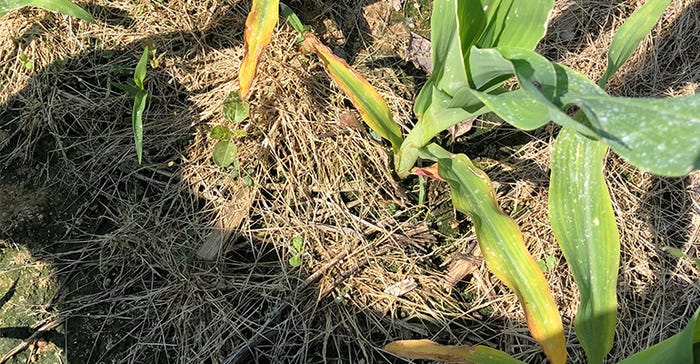March 1, 2020

Sponsored Content
Potassium (K) plays vital roles within corn plants for carbohydrate, nutrient, and water flow. It is instrumental in gas exchange from the plant to the atmosphere as it regulates the opening and closing of the stomata of the leaf; it is also a key component in cell walls which add to stalk strength. Potassium is essential for photosynthesis, maximizing water use efficiency, helping maintain plant health, increasing test weight of grain, and nitrogen use efficiency. A corn plant requires almost as much K as nitrogen (N); however, when looking at soil test values across the Midwest, soil test K values have been falling. This is largely due to increased grain yields removing higher amounts of K from the soil and insufficient K applications.
Be on the Lookout
Wet springs followed by dry, hot summers tend to expose K shortages in the field. The wet spring inhibits root development, and then dry soil conditions limit mass flow of K to the (smaller) root system during the period that plants have a high K demand — the vegetative growth stage. Other conditions that limit root growth, like sidewall compaction, can result in K deficiency symptoms. Tissue samples will indicate in-season K deficiency.
What to Look For
Potassium deficiency can manifest in many ways. A very common sign of K deficiency is scoring or firing along the leaf margins, while the midrib or center of the leaf remains green. Potassium is mobile in the plant, so firing will appear first on the bottom, older leaves of the plant. Potassium-deficient plants grow slowly, are stunted in appearance, have poor root systems, and weak stalks. The grain also tends to be small and shriveled, with lighter test weights.

How Much K Do You Need?
Optimal soil test K levels differ across the Midwest. Depending on geography, soil K at 100 to 160 ppm is acceptable. Coarse soils will trend lower, and soils with high organic matter will contain higher amounts of K. It is imperative to consider base saturation (BS%) when making K application decisions. Base saturation is the percentage of the soil’s cation exchange capacity (CEC) that is occupied by the bases (K, Mg, Ca, and H). Critical K levels are often calculated as a function of CEC using the formula K>(75 + 2.5 x CEC). Adequate BS% of K is generally anything over 3%. High N environments can dilute available K; therefore, high-yielding environments require additional applications. Be aware that excess calcium can replace potassium on the CEC, so it’s important to monitor proper soil pH and BS% of calcium.
The amount of K2O removed per bushel of corn is approximately 0.25 lb./Bu.; therefore, a 240 Bu./A. corn crop removes 60 lb. K2O/A. in the grain. If harvesting the stover as well (corn stalks, silage etc.) that same 240 Bu./A. crop will remove 264 lb. of K2O/A. from the field.
DID YOU KNOW?
Plants from V4 to V12 can use up to 5 lb. of K/A. per day!

Management Options
In corn production, 68% of the K needed for the plant is taken up between the V4 to V12 growth stages. The rapid uptake period often coincides with sidedress N applications, so would it be practical to add a potassium sulfate product to the sidedress application? To answer this, we first must ask ourselves some questions:
Is my K BS lower than 3%?
Are my soil test K levels lower than 160 ppm?
Are the soils cool and wet?
Am I using high amounts of N?
If you answered yes to any of these questions, consider adding or increasing K applications to your cropping system.
Potassium is water-soluble, so K inside corn stalks can overwinter and be washed out of the stalks as they degrade. To make the K in plant residue available more quickly, consider using a residue management system that chops or perforates residue, or include a biological product that expedites residue breakdown.
Potassium is an essential nutrient for high-yielding corn, and it requires active management to achieve higher corn yields. Monitor potassium levels as a part of your comprehensive soil testing regime and develop a plan to ensure adequate plant-available potassium during the growing season.
Beck’s is the largest family-owned retail seed company in the United States that serves farmers in Illinois, Indiana, Iowa, Kentucky, Michigan, Minnesota, Missouri, Ohio, South Dakota, Tennessee, and Wisconsin. According to a recent seed industry survey, Beck’s ranks as the fourth largest corn and soybean brand in the United States. At their core, all Beck’s employees are Farmers at Heart. It stands for something special. It has soul. It has truth. And it represents a community of farmers, employees, and dealers who strive each day to seek challenges, push boundaries and innovate. Beck’s has, and always will be, proud to serve a community of farmers who love what they do and who are proud to be… Farmers at Heart. For more agronomic new and information, visit Beck’s Agronomy Talk page or blog at BecksHybrids.com.
Sources:
University of Minnesota https://extension.umn.edu/phosphorus-and-potassium/potassium-crop-production
IPNI Estimates of Nutrient Uptake and Removal, May 2014.
Purdue Pest Management & crop Production Newsletter (12 July 1996) https://www.agry.purdue.edu/ext/corn/news/articles.96/sb9606.htm
About the Author(s)
You May Also Like




